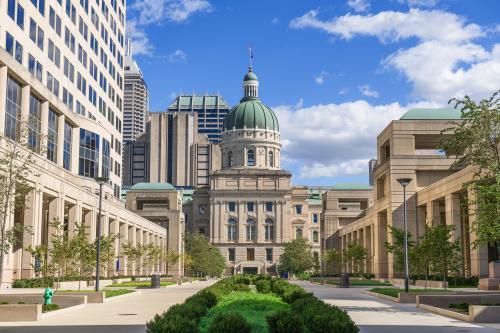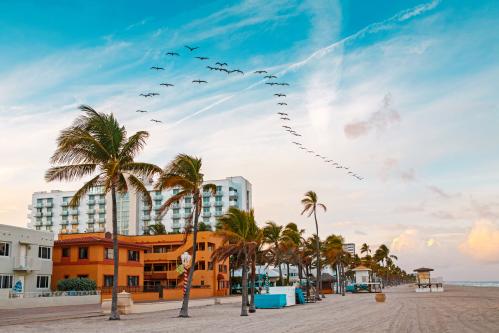Hopes persist that a burst of relocations by tech companies and remote workers will revitalize the American heartland. Recent location announcements by firms such as Google and Apple have generated optimism, magnified by a steady stream of articles about tech workers fleeing the coasts. Maybe remote work and pandemic-spurred moves really are going to redistribute economic vitality more evenly across the country after a decade of excessive concentration in coastal “superstar” cities.
Or maybe not: While aspects of the corporate relocation story may be real, new evidence raises questions about the true potential of the remote-work-driven renewal storyline.
On the corporate side, firm announcements and news accounts continue to track what seems to be an uptick in moves of Bay Area and other big-city tech firms to noncoastal regions. Importantly, however, many of these seem to involve moves or investments into existing secondary tech centers, such as North Carolina’s Research Triangle (where Google and Apple are opening engineering hubs) or Austin, Texas (where Tesla is building a manufacturing center) rather than truly new places, let alone distressed areas. Places like Denver and Nashville, Tenn. have also seen arrivals by tech firms from the coasts.
Such moves are likely a good thing overall for the nation’s imbalanced tech economy. To be sure, the new arrivals may further strain already tight housing and labor markets. Yet even so, too much of the nation’s highest-level economic activity remains jammed into a short list of coastal “superstar” cities. The nation needs more dynamic regional tech centers.
On the worker side, though, the current narrative is that the widespread shift to remote work amid the COVID-19 pandemic has created a massive pool of footloose workers who are rapidly exiting the big coastal tech hubs and heading for the heartland, where they will boost the inland economy. Plenty of anecdotes and commentators have pushed this narrative over the past 15 months.
However, the numbers don’t really add up. An April CBRE analysis on migration patterns—based on frequently updated U.S. Postal Service data—reported that while the outflow of people from dense, high-cost urban metro areas accelerated in 2020, the flows were rather modest in most cases (with the exceptions of the Bay Area, New York, and Seattle). What’s more, most of the moves were short to moderate distances, often to nearby counties—not the nation’s interior.
To drill down further, we used the CBRE data to look more specifically at moves from the San Francisco and San Jose, Calif. metropolitan areas to the heartland, as defined by “State of the Heartland: Factbook 2018,” a joint product of Brookings and the Walton Family Foundation. Through that analysis, we found that in 2020, there was a gross total of 700,000 outbound moves from the Bay Area—but only 12,000 address changes were filed for moves from the Bay Area to the 19 classic heartland states. These 12,000 moves do not seem nearly enough to significantly revitalize the region.
We also looked at moves out of New York, Los Angeles, Washington D.C., and Seattle. Even after adding the Mountain West states to the list of heartland destination states, the gross total out-migration to the heartland rises to only 198,000, out of 4.7 million outbound moves from those metro areas.

To put that in perspective, the 198,000 gross incoming movers from the coastal “superstar” metro areas amount to less than 0.2% of the 125 million heartland and Mountain West population—again, not enough people to significantly revitalize the nation’s massive interior and its challenged small towns and cities. And even these modest gains could be eroded or outright eliminated by continuing outflows from the heartland and Mountain West to superstar metro areas, including workers who only moved temporarily and now are returning to the coasts.

This analysis isn’t the only piece of data arguing against a major migration-driven turnaround. Remote work is declining rapidly, as more firms and workers prioritize at least some in-office work each week. To be specific, last month’s jobs report showed that the share of U.S. management and professional workers teleworking or working from home because of the pandemic had slid from 57% in May 2020 to just 30% in May 2021.

This suggests that for all the discussion of new work patterns and possible relocations for millions of professional workers, fewer and fewer will be fully footloose in the coming years, as remote work settles into a new level that will be higher than the pre-pandemic norm but lower than now.
All of which is to say that most heartland cities should not hold their breath for quick, migration-driven turnarounds generated by the arrival of new tech or professional workers from the coasts.
To be sure, some of the nation’s established secondary tech hubs (Austin, Denver, the Research Triangle) or already dynamic smaller centers (Cleveland; Boise, Idaho; Madison, Wis.; Jackson, Miss.) may stand to see some benefits from firm and worker relocations. However, that will not be the case for the vast majority of places.
Given that, “attraction” strategies seem like a long shot for the places most in need of growth as the pandemic eases and remote work declines. Communities across the country should instead focus on the kind of basic block-and-tackling that will lead to more robust growth overall and a higher quality of life for residents. This includes the harder work of building authentic growth sectors; developing a skilled and diverse digital workforce; deploying robust transportation infrastructure for local residents; and enacting policies that support workers and their families, such as investment in education, accessible child care, and universal paid sick and family leave. New and better place-based and place-conscious federal policies would also help, such as the creation of sizable regional tech hubs in new places, or new investments in the nation’s historically Black colleges and universities (HBCUs) and minority-serving institutions (MSIs).
In sum, it doesn’t look like the remote work explosion is going to magically transform the nation’s interior. Instead, regional leaders will need to continue making the kind of conscious, long-term investments that have long been the drivers of local economic growth and high standards of living.
The Brookings Institution is committed to quality, independence, and impact.
We are supported by a diverse array of funders. In line with our values and policies, each Brookings publication represents the sole views of its author(s).










Commentary
Remote work won’t save the heartland
June 24, 2021